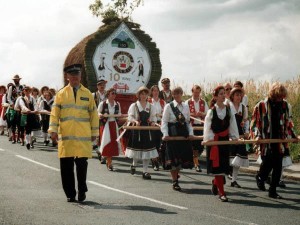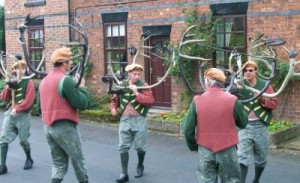Morris Dancing
The Morris dance is common to all inhabited worlds in the multiverse.
It is danced under blue skies to celebrate the quickening of the soil and under bare stars because it’s springtime and with any luck the carbon dioxide will unfreeze again.
The imperative is felt by deep-sea beings who have never seen the sun and urban humans whose only connection with the cycles of nature is that their Volvo once ran over a sheep.
It is danced innocently by raggedy-bearded young mathematicians to an inexpert accordion rendering of “Mrs Widgery’s Lodger” and ruthlessly by such as the Ninja Morris Men of New Ankh, who can do strange and terrible things with a simple handkerchief and a bell.
Terry Pratchett – Reaper Man
Often seen as a quintessential English pastime, the full origins of Morris Dancing are lost in the mists of time. While there are mentions of sword dances, mumming plays, guising and other activities that we now associate with Morris, but it isn’t until the late 15th century that the term is first recorded. Even then, the term “Morys” seems to refer to a court dance rather than the public spectacle that it is today.
In 1492, the Spaniards having driven the Moors out of the country celebrated with a pageant known as a Moresca which included a sword dance. It is likely that this is where the association between the name and the form of dance originates. With sword dances widespread around the world, it is probable that Morris was either a renaming or an adaptation of a much older tradition, the sticks commonly used by Morris Dancers today a remnant of the original swords.
In 1600, the famous actor William Kemp (a member of the Lord Chaiberlain’s men alongside William Shakespear and Richard Burbage) set out on a Morris Dance from London to Norwich, which he detailed in a pamphlet “Nine Daies Wonder” having covered the distance in nine days of dance over the course of several weeks.
Morris Dance continued to be practiced by the peasantry up until the English Civil War when it was supressed by the Puritans. However, it was revived with the restoration of the Monarchy, the springtime festival of Witsun conveniently coinciding with the birthday of the new King. The tradition continued up until the Industrial Revolution when social changes of the time led to its decline.
The revival of Morris Dancing came about on Boxing Day 1899 when Cecil Sharpe saw a performance by the Headington Quarry morris side and started to collect together the tunes and dances. This revival during the start of the 20th century lead to the formation of the Morris Ring in 1936.

Littleborough Rushbearing
The 1960s folk revival brought with it an explosion of Morris teams including women only and mixed sides. The debate over the legitimacy of women dancers and The Morris Ring’s men only stance lead to the creation of two other Morris organisations, The Morris Federation (originally women only) and Open Morris.
Modern morris dances are dominated by three styles, Cotswold, North West (or Clog Morris) and Border but there are several other styles, Molly, Longsword and Rapper that come under the morris umbrella as well as unique styles such as the Abbots Bromley Horn Dance and the Britannia Coconut Dancers.

